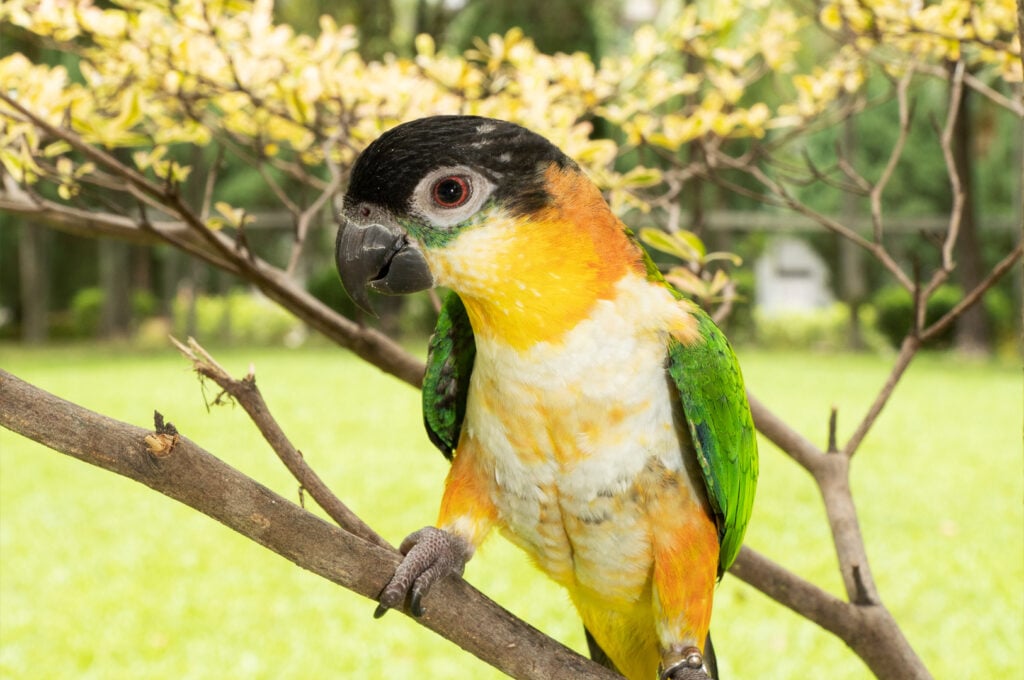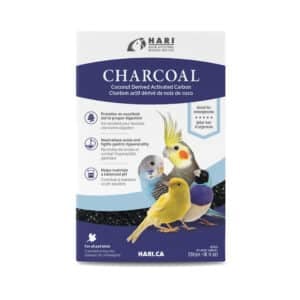Your cart is currently empty!
HARI Official Brand Site
Common Species
White Bellied Caique (Pionites xanthosmerius),
Black Headed Caique (Pionites melanocephalus).
Origin/Habitat
South America
Caiques are playful, comical little birds that enjoy the opportunity to explore. Always on the move, these colourful, intelligent, and energetic parrots are a joy to have around. They thrive on human interaction, are highly affectionate, and form strong bonds with their owners. With their sharp minds and ability to learn quickly, they are adept at picking up new tricks. Caiques are an ideal option for pet owners seeking an amusing feathered companion.
Caiques are indigenous to South America, inhabiting regions near the Amazon River that stretch from Bolivia and Peru to Brazil. These birds tend to flock together and prefer to reside on the periphery of forests located in humid and tropical climates.
Caiques are a unique bird species with four distinct types. Unfortunately, two of them – the Green-thighed Parrot (Pionites leucogaster) and Yellow-tailed Parrots (Pionites xanthurus) – are critically endangered and rarely seen in captivity. Meanwhile, the two most common species kept as pets are the White Bellied and the Black Headed Caiques.
Generally, Caiques have a lifespan of 20 to 30 years, but some may live beyond that.
Health Booklet
Keeping track of bird health by recording their growth, development, behavior and environment in a booklet can help ensure that your companion parrot will be healthy and happy for many years to come.
Physical Description
Caiques are a type of medium-sized parrot that measure between 23.5 to 28 cm (9 to 11 inches). With their unique blend of green, black, white, orange, and yellow feathers, they are truly stunning birds.


All Caiques have white bellies, but only the Black Headed Caique features black feathers on its head. Interestingly, while the White Bellied and Black Headed Caiques may hybridize in captivity, they rarely do so in the wild due to their geographical preferences.
Sex
DNA sexing is the most accurate way to determine the sex of Caiques. Much like many of our other parrot species, a DNA blood test performed by a qualified experienced avian practitioner is also a good tool to determine sex of the bird.
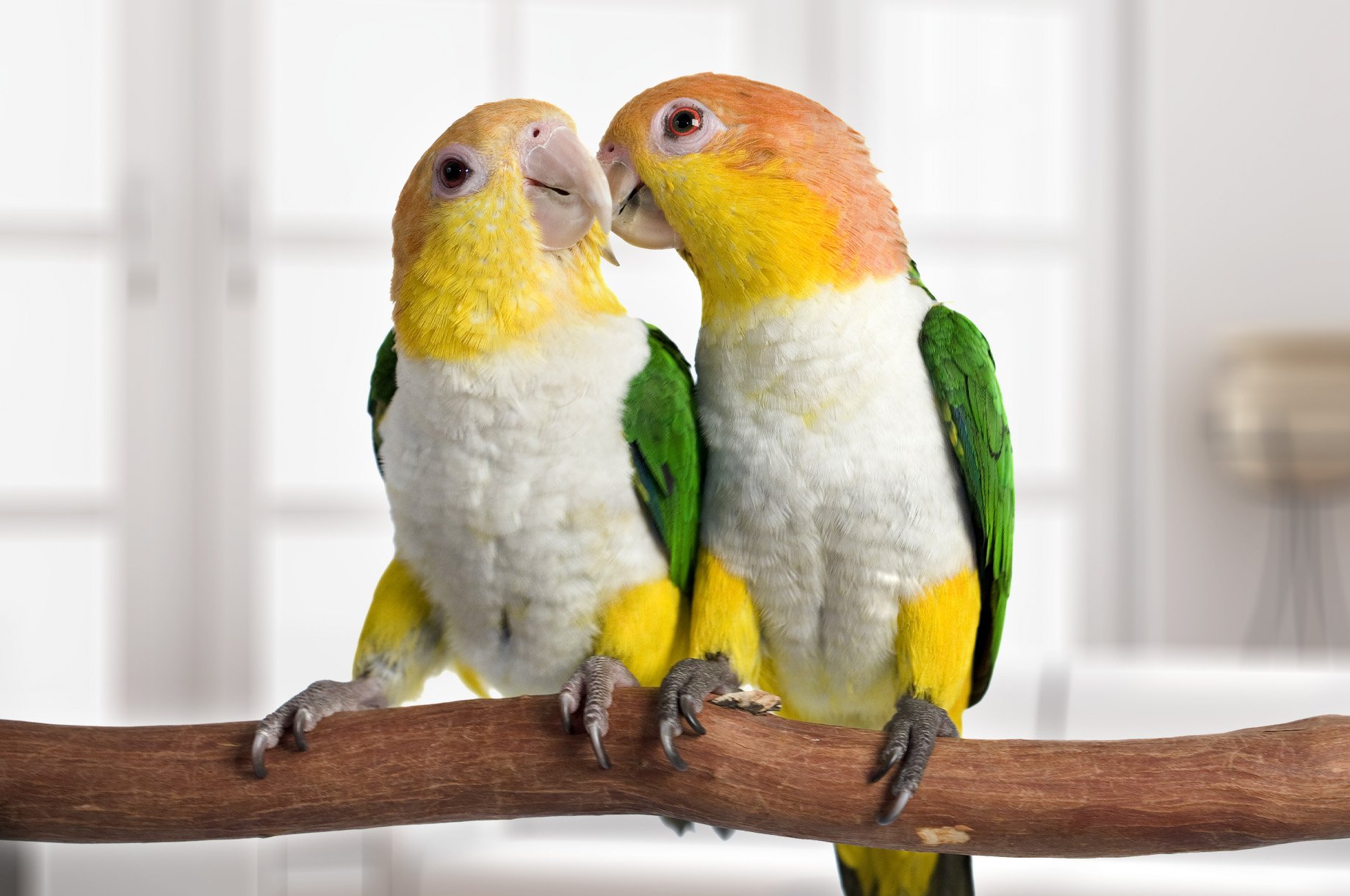
Noise Level/Speech/Song
Though caiques can be quite noisy, they don’t come close to the volume of an amazon or macaw. While they can imitate repetitive noises like a phone or microwave, they aren’t known for using human language like some other parrots.

Intelligence & Learning
Caiques are always ready for fun and adventure, and it doesn’t take much to get them excited and engaged. However, their competitive nature means that what starts out as a playful activity can quickly turn into an extreme state of excitement. As a result, it’s important to exercise caution when dealing with young children. If a Caique becomes overly stimulated, it’s crucial to give the bird some space to calm down by speaking softly and avoiding sudden movements.
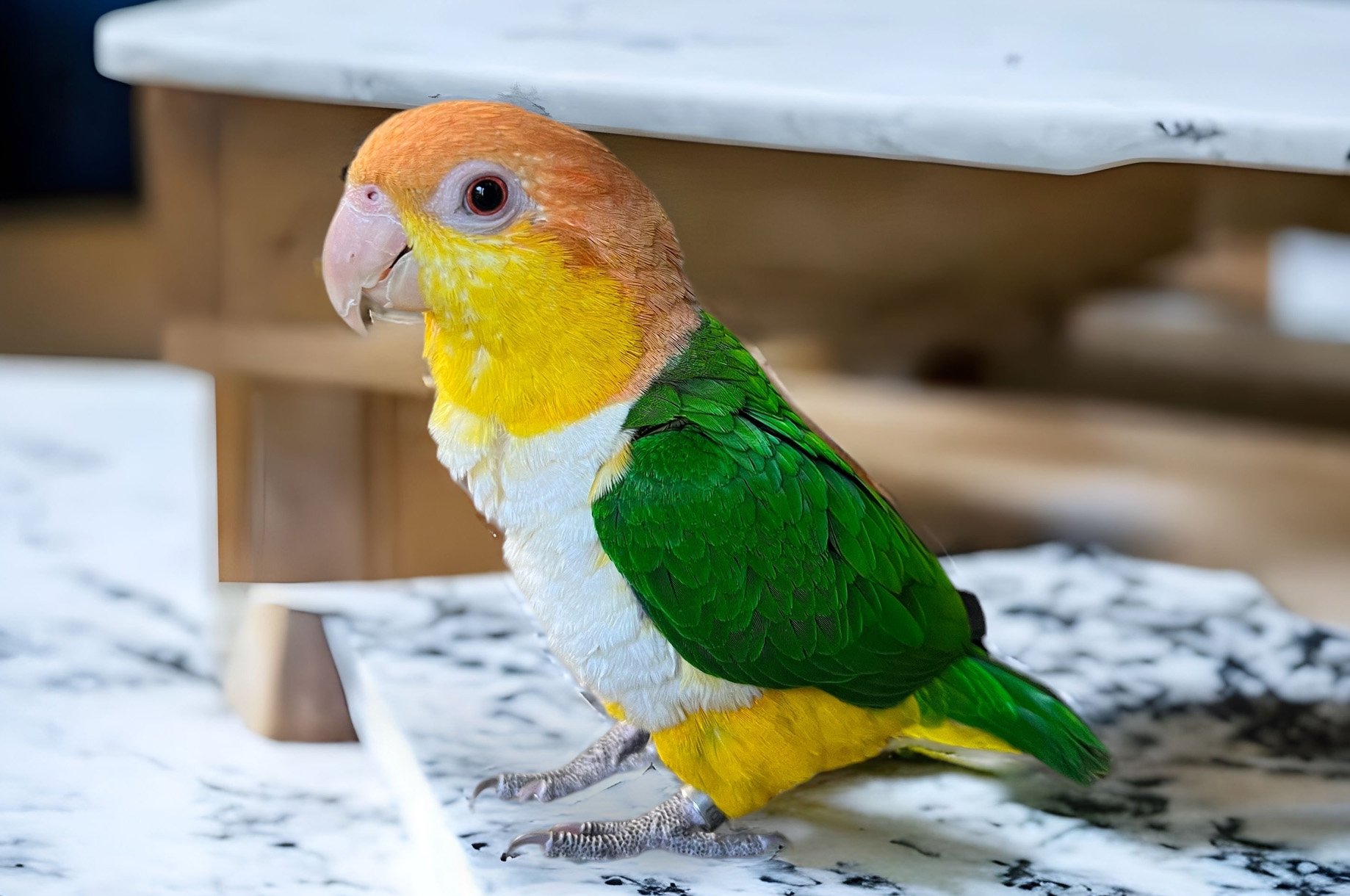
Personality Traits & Behaviours
Caiques are known for their love of exploration and desire to be the center of attention. They are highly energetic and enjoy discovering new play things such as toys and play stands. However, if left unattended, these curious birds can sometimes get themselves into sticky situations.

Threats/Conservation
While there is little threat to the commonly kept as companion species, the White Bellied Caique and the Black Headed Caique, the other two species, the Pionites leucogaster- Green-thighed Parrot, and Pionites xanthurus-Yellow-tailed Parrots, are very endangered and are rarely seen in captivity.

Relationship with Humans
To prevent unwanted behavior in domestic settings, it’s essential to begin training Caiques at a young age. Without proper education, these fledglings can easily take over their surroundings, establish boundaries, and enforce their own laws. However, Caiques respond well to positive reinforcement, gentleness, patience, and persistence. Given their intelligence, they may try to challenge your authority by biting if they feel their limits are not being respected. Therefore, positive reinforcement is crucial in establishing a strong bond with your Caique.
Care
When selecting a bird cage for your Caique, keep in mind that the cage should be as large as possible and at least two and a half times the width of the bird’s wingspan in all directions. The spacing between the bars should not be wide enough for the bird to stick its head through, and its tail feathers should not touch the bars when it’s perched comfortably. Additionally, consider your bird’s beak strength to determine the appropriate gauge of the bars, as some birds can bend the bars and escape.
For optimal living conditions, a rectangular cage with horizontal bars in which your bird has plenty of room to climb and play is the best environment for your parrot. Ensure that the cage is located in a well-ventilated room with plenty of natural light, but away from direct sunlight and drafts. Your bird will want to be part of the action but not necessarily in the middle of it. Avoid placing the cage in the kitchen, as there are many hazards that can harm your bird, including heated PTFE coated pans (better known as TeflonTM), hot stoves, pots of boiling water, and cooking fumes.
It’s important to clean and disinfect the cage and its accessories thoroughly on a weekly basis. Additionally, provide your bird with clean water and food dishes every day. Your bird needs time out of the cage every day for socialization and exercise, and a play gym with toys and enrichment food is a great way to keep it active. However, make sure it does not have access to potential dangers such as open doors or windows, toilets with the lid up, hot stoves, moving ceiling fans, or large panes of glass. Also, ensure that it does not chew on or ingest anything unsafe, such as treated or painted wood or unsafe house plants. Lastly, avoid keeping your bird in a room where sprays such as perfume, hair spray, air fresheners, or aerosol sprays are used frequently. Make sure your bird stays healthy by providing them with fresh food and water every day. Don’t forget to wash their dishes daily!
For the safety of your parrot, we strongly advise against leaving it alone with other household pets like dogs, cats, or ferrets.
When it comes to feeding your Caique, there are numerous opinions out there. Our philosophy is to prioritize a high-quality extruded diet, like Tropican, as the foundation of their nutrition. Supplementing this with other healthy enrichment foods can provide your Caique with the variety they crave. Pelleted diets are the optimal choice to ensure your Caique maintains good health. While a pelleted bird food can make up a considerable portion of your Caique’s diet, incorporating gourmet seeds, mixtures of dried fruits, vegetables, and nuts (such as Tropimix), beans, and fresh fruits and vegetables is essential for the variety and nutritional benefits they offer. Sensible, healthy table foods like hard-boiled eggs, multi-grain toast, unsalted crackers, and cooked pasta and rice can also be given in small amounts as treats.
However, it’s important to avoid feeding your parrot any unhealthy people foods, including chocolate, salty foods, and those containing caffeine and alcohol. Check out our feeding recommendations for most parrot species.
Lastly, always ensure your Caique has access to fresh, clean drinking water.
Many bird owners will cover the bird cage at night to help block out extra light and to provide a setting of security. A cover can also keep the cage warmer (for those living in colder climates).
Your bird’s sleep cage should be outfitted with a comfortable perch placed at the highest level possible to provide security and maintain healthy feet. If your bird is prone to night terrors or you don’t use a cage cover, consider installing an infrared basking light or small night light in the room. Keep in mind that parrots need 10-12 hours of uninterrupted sleep for optimal health.
Improperly sized or dirty perches contribute to Pododermatitis or Bumblefoot. Offer your bird at least three types of perches appropriately sized for his feet: cotton or sisal rope; natural wood perches-with a variety of diameter. Make sure the perches are the right size for your bird’s feet. You should add natural branches to the cage to supplement the standard perches. Fresh branches are great for perching and chewing. Opt for branches like willow, alder, ash, birch, or apple, but replace them every 4-6 weeks and remove the leaves.
To ensure your bird’s safety and comfort, it’s crucial to keep their perches clean. If you use cotton or sisal rope for perches, regularly inspect them for any signs of fraying or loose strands. Due to normal wear and tear, perches will often need to be replaced. If you use a grooming perch, avoid placing it at the highest level of the cage or near food and water dishes.
Caiques are known for their love of toys! When choosing toys, look for ones that are durable, size-appropriate and provide enrichment. Make sure to rotate their toys every week or two to stave off boredom. If you’re unsure which toys are suitable, check out the Smart Play and Active Play toys for recommendations based on your bird’s size and needs.
Most Caiques do respond well to consistent positive behaviour training sessions. Start training your bird as soon as possible. Begin with basic commands such as “step up” and “step down”. Use positive reinforcement techniques and praise to encourage good behavior. Time away from your parrot’s main cage is a great time for training, especially with the use of a training stand and your bird’s favourite treat.
Socialize your parrot by exposing them to a variety of people, places, and experiences. Introduce them to new toys, foods, and environments to help them become comfortable with new situations. This will also help to prevent fear and aggression towards strangers.
Daily bathing is essential to the health of your bird. Bathing moisturizes nasal passages and feet and keeps your birds’ feathers and skin in excellent shape. Caiques will often bathe on their own if opportunity is available. If your bird is reluctant to bathe on his own, you can use a spray bottle with warm water to gently mist him or use a shower perch. Be sure to remove seeds or pellets from the cage before misting as damp food can grow mold and bacteria. Always bathe your bird early in the day and let him dry naturally in a draft free area.
While trimming a parrot’s flight feathers is a matter of personal choice, many parrot owners prefer to keep their bird’s flight feathers trimmed. This process is painless, similar to a regular haircut. This process is painless and should be done when the bird moults, typically twice a year. Additionally, you will need to regularly inspect and groom their toenails. It is highly recommended that a professional bird groomer trim your bird’s nails and wings, as it’s easy to accidentally clip a blood feather if you are unsure of what you’re doing. Keep in mind that wing trimming is not a foolproof method of preventing flight; even just one or two grown-in feathers can give your bird flight ability. As a result, it is essential to never take your bird outside without a secure cage or a properly fitted bird harness.
It is important to provide parrots with a safe environment to ensure the longest lifespan. The following is a list of common household dangers: Non-stick surfaces (like TeflonTM coated pans), oven cleaner and self-cleaning ovens, cigarette smoke, paint and paint fumes, scented candles, household cleaners, floor polish, hairspray, chlorine bleach, perfume, aerosol sprays, nail polish and nail polish remover fumes and ingesting harmful or toxic house plants.
It’s important to educate everyone in the household about food and other items that may be poisonous to parrots, such as avocados, chocolate, coffee beans, onions, salt, and fruit seeds or pits. Additionally, ceiling fans, cupboards, blinds, open doors, and windows all pose potential risks for your pet, as they may fly into them, get trapped, or simply fly away.
Birds have a tendency to hide indications of illness. As such, it’s crucial to pay attention to minor changes in your bird’s health or behaviour. To ensure that your bird receives optimal health care, it is recommended that you take them to a veterinarian once a year for a comprehensive evaluation and preventive health care plan. Some veterinarians specialize in treating birds and/or exotic pets, also known as avian/exotic vets. While some clinics offer routine bird appointments, they may suggest that you consult with a certified avian veterinarian for more complicated cases. By working with an avian veterinarian, you can receive valuable guidance on how to properly care for your bird.
Availability in the Pet Market
Caiques can be obtained from an avian specialty shop, pet dealer, or a reputable breeder. Online adoption organizations and rescues can also be a viable option for those looking to adopt a Caique.
… A well trained Caique loves to perform tricks!
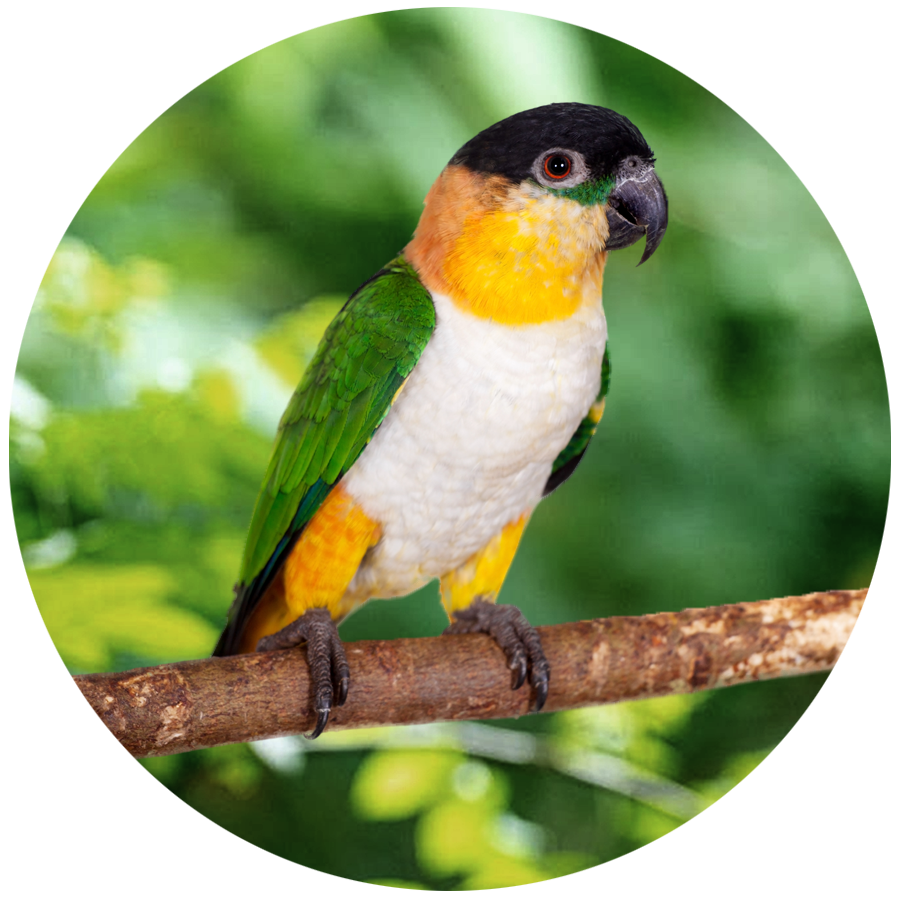
Aviculture
Breeding Habits
In the wild, Caiques will nest annually, typically laying 3-4 eggs per clutch, but the timing depends on the geographic location and species. In aviary settings, Caique species usually nest during early spring and sometimes in the fall, producing an average of 3 eggs per clutch. In captivity, Caiques are considered mature at three years of age.
Hatchling to Fledgling
Aviculturists who focus on pet birds typically allow parent birds to look after their offspring for 2-3 weeks before taking over with hand-feeding. It’s important for breeding parrots to be in good health and have a balanced diet that provides for both parents and nestlings. To meet nutritional requirements, consider feeding your birds Tropican High Performance 4mm, 8mm, Sticks and Tropimix Small & Large Parrot, as well as vegetables and fruits that are high in beta carotenes. Additionally, adding Prime Vitamins to the seed-based diet of breeding pairs can be beneficial.
Suggested Products
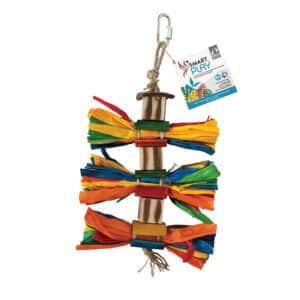
Smart.Play
Rollie Pollie, Enrichment Parrot Toy for Medium Birds
Enrichment Parrot Toy for Medium Birds

